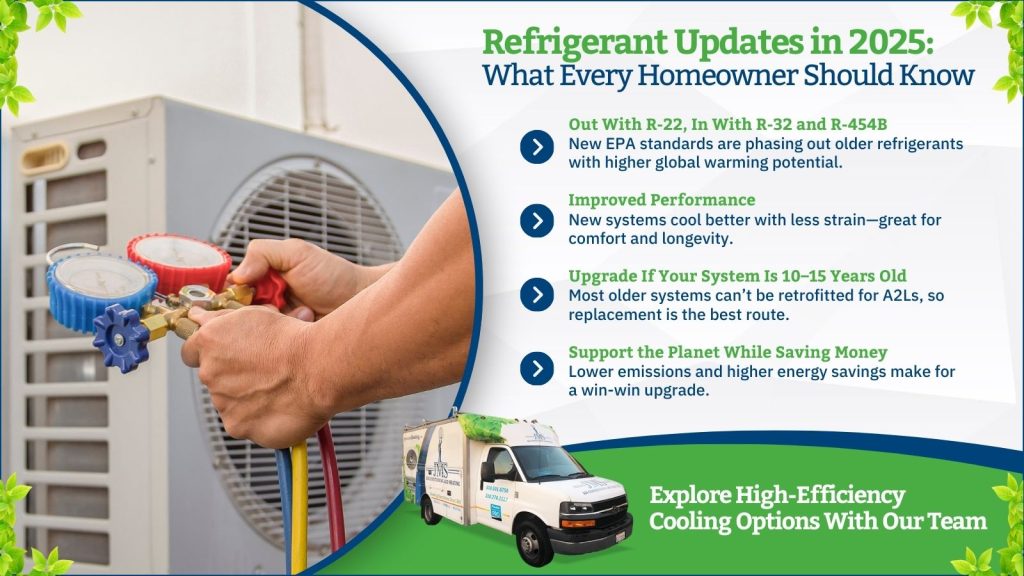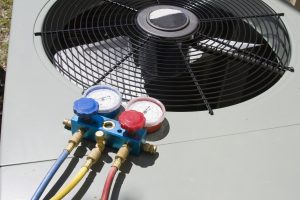If you’re curious about the latest developments in refrigerant technology, this guide is your go-to resource for the 2025 refrigerant transition and what recent changes mean for you as a homeowner. With an increased emphasis on environmental impact and energy efficiency, understanding these changes is crucial for homeowners and industry professionals alike.
Keep reading to learn more about how innovative refrigerants can enhance system efficiency while reducing environmental harm. Then give our team a call to discuss your upcoming AC maintenance, repair, or replacement when you’re ready.

Exploring the A2L Transition
The HVAC industry is currently undergoing a significant transition with the introduction of A2L refrigerants at the beginning of this year. These refrigerants are designed to offer lower global warming potential compared to traditional refrigerant options while maintaining performance standards.
The A2L classification indicates a slightly lower flammability risk, which allows these refrigerants to be used safely in a range of applications – with proper precautions, of course. This shift represents a key step toward more sustainable and environmentally friendly HVAC solutions.
The current goal set by the EPA is to reduce the impact of harmful refrigerants by 85% within the next 11 years – by 2036. New refrigerants introduced this year include R-32, R-454B, and R-1234yf. They are more environmentally friendly alternatives compared to the R-22 refrigerant that is currently used.
Efficiency and Environmental Benefits
New refrigerants offer numerous advantages that go beyond environmental considerations. Their improved thermodynamic properties allow systems to operate more efficiently, potentially lowering your overall energy consumption for heating and cooling as well as reducing utility costs. For you as a homeowner, this means enhanced comfort without the burden of increased operational expenses.
Moreover, by reducing greenhouse gas emissions, these new refrigerants contribute to a healthier planet, aligning with broader efforts to combat climate change. Prior to this, the most recent refrigerant changes were introduced in 2020. We expect to see additional steps toward greater efficiency and safety in future years as technology advances.
Practical Considerations for Homeowners
There are a few considerations to make when deciding if it’s the right time to transition to a system that utilizes A2L refrigerants. Many older ACs and heat pumps cannot be modified to use new refrigerants, meaning that you’ll have to upgrade if you want to enjoy the benefits. Great reasons to upgrade now include:
- Your current HVAC efficiency is suffering and you stand to save money.
- Your current system is 10-15 years old and it’s nearing time for a replacement.
- You are spending a lot on frequent repair needs for your current unit and an upgrade is a better investment.
- You want to switch from a different type of cooling system to a whole-house AC or heat pump.
- You are taking steps toward decreasing your carbon footprint and lessening your environmental impact.
Taking Action for a Sustainable Future
Adopting new refrigerant technology is not only a step toward enhanced system performance, but also a commitment to environmental stewardship. When you take the initiative to upgrade your system, you contribute to reducing the overall environmental impact of HVAC operations collectively.
Small steps can add up to big changes when we work together. In addition to enjoying better efficiency and performance, you’re actively participating in a broader effort to make our world a greener place.
JMS Air Conditioning and Heating has your back. Call us today to schedule an appointment for your AC system care in Glendale, CA!


